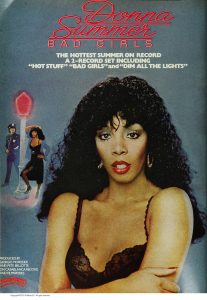
In 1979, New York’s Cosmopolitan Magazine highlighted Donna Summer’s new studio album “Bad Girls”. The magazine cover consists of Donna Summer wearing a revealing black laced dress. In the background of the photo she is posing next to a cop, which reflects her image as a “bad girl”. She is wearing bright red lipstick, and her makeup is extremely exaggerated which adds a sexually appealing aspect to her appearance. Her clothing is revealing, and the color black works as a mysterious color, which urges one to desire more from Donna Summer. This source connects back to my topic because it shows the ways in which Black female artists have reclaimed their sexual identities despite being faced with hypersexualized stereotypes that White Americans have continued to perpetuate on Black women since American Chattel Slavery. Summer removed the negative connotation of the words “bad girls” since she proudly embraces that identity through the image and her album.

Released in 1994, Kara Walker’s art exhibition debuted in New York City. It is called, “Gone: An Historical Romance of a Civil War as it Occurred b’tween the Dusky Thighs of One Young Negress and Her Heart”. It is a wall installation. The wall installation consists of caricatures of Black folks during the Slavery Era in America. The ways in which Kara utilized satire to depict violence that occurred against African Americans during American Chattel Slavery reflects her bravery to attempt to shock the eyes of her viewers. She painted the stereotypical images of her own identity in order to influence an emotional response from viewers who may subconsciously have a tendency to ignore the past. Its colors consists of solely white and black, and her intention was to deconstruct that validity of whiteness and blackness as racial ideologies due to the falseness of eugenics.
